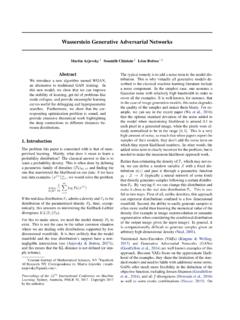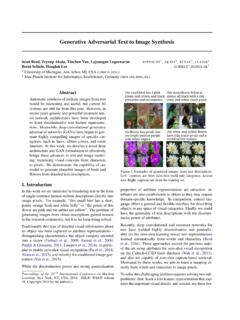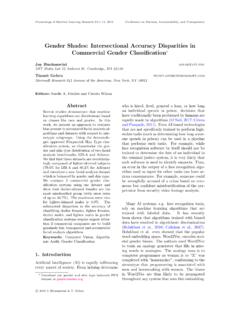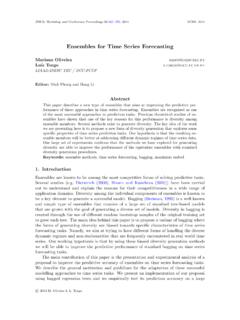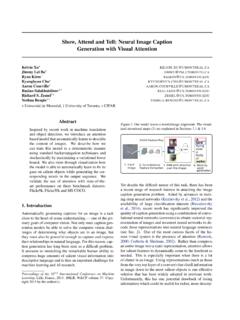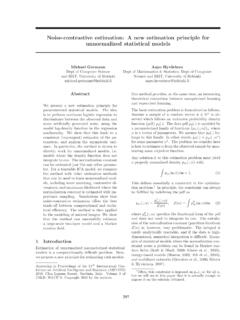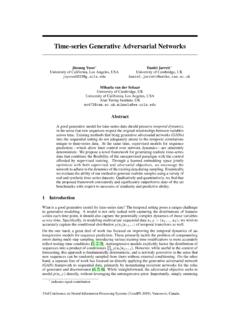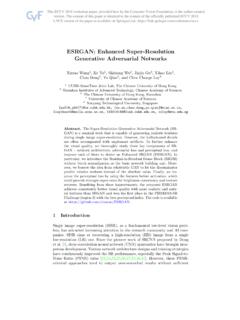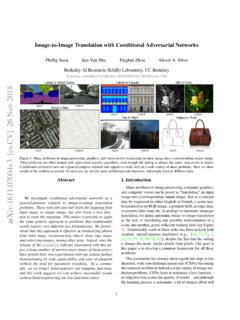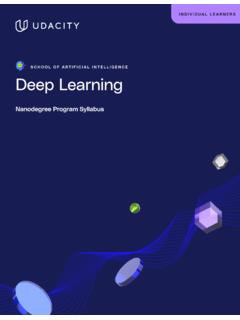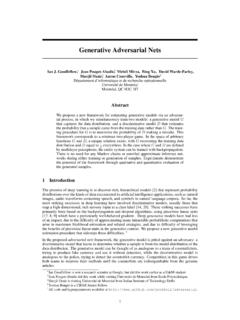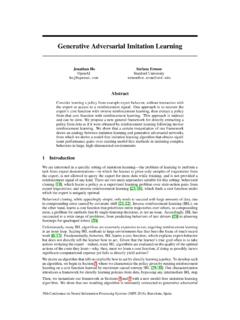Transcription of Self-Attention Generative Adversarial Networks
1 Self-Attention Generative Adversarial NetworksHan Zhang1 2 Ian Goodfellow2 Dimitris Metaxas1 Augustus Odena2 AbstractIn this paper, we propose the Self-Attention Gen-erative Adversarial network (SAGAN) whichallows attention -driven, long-range dependencymodeling for image generation tasks. Traditionalconvolutional GANs generate high-resolution de-tails as a function of only spatially local pointsin lower-resolution feature maps. In SAGAN, de-tails can be generated using cues from all featurelocations. Moreover, the discriminator can checkthat highly detailed features in distant portionsof the image are consistent with each other. Fur-thermore, recent work has shown that generatorconditioning affects GAN performance. Leverag-ing this insight, we apply spectral normalizationto the GAN generator and find that this improvestraining dynamics.
2 The proposed SAGAN per-forms better than prior work1, boosting the bestpublished Inception score from to andreducing Fr echet Inception distance from on the challenging ImageNet dataset. Visu-alization of the attention layers shows that the gen-erator leverages neighborhoods that correspondto object shapes rather than local regions of IntroductionImage synthesis is an important problem in computer vi-sion. There has been remarkable progress in this direc-tion with the emergence of Generative Adversarial Net-works (GANs) (Goodfellow et al., 2014). GANs based ondeep convolutional Networks (Radford et al., 2016; Kar-ras et al., 2018; Zhang et al.) have been especially suc-cessful. However, by carefully examining the generatedsamples from these models, we can observe that convo-1 Department of Computer Science, Rutgers University2 GoogleResearch, Brain Team.
3 Correspondence to: Han of the36thInternational Conference on MachineLearning, Long Beach, California, PMLR 97, 2019. Copyright2019 by the author(s).1 Brock et al. (2018), which builds heavily on this work, hassince improved those results GANs (Odena et al., 2017; Miyato et al., 2018;Miyato & Koyama, 2018) have much more difficulty inmodeling some image classes than others when trained onmulti-class datasets ( , ImageNet (Russakovsky et al.,2015)). For example, while the state-of-the-art ImageNetGAN model (Miyato & Koyama, 2018) excels at synthe-sizing image classes with few structural constraints ( ,ocean, sky and landscape classes, which are distinguishedmore by texture than by geometry), it fails to capture geo-metric or structural patterns that occur consistently in someclasses (for example, dogs are often drawn with realisticfur texture but without clearly defined separate feet).
4 Onepossible explanation for this is that previous models relyheavily on convolution to model the dependencies acrossdifferent image regions. Since the convolution operator hasa local receptive field, long range dependencies can only beprocessed after passing through several convolutional could prevent learning about long-term dependenciesfor a variety of reasons: a small model may not be ableto represent them, optimization algorithms may have trou-ble discovering parameter values that carefully coordinatemultiple layers to capture these dependencies, and theseparameterizations may be statistically brittle and prone tofailure when applied to previously unseen inputs. Increasingthe size of the convolution kernels can increase the represen-tational capacity of the network but doing so also loses thecomputational and statistical efficiency obtained by usinglocal convolutional structure.
5 Self-Attention (Cheng et al.,2016; Parikh et al., 2016; Vaswani et al., 2017), on theother hand, exhibits a better balance between the ability tomodel long-range dependencies and the computational andstatistical efficiency. The Self-Attention module calculatesresponse at a position as a weighted sum of the features atall positions, where the weights or attention vectors arecalculated with only a small computational this work, we propose Self-Attention Generative Adver-sarial Networks (SAGANs), which introduce a self -attentionmechanism into convolutional GANs. The self -attentionmodule is complementary to convolutions and helps withmodeling long range, multi-level dependencies across imageregions. Armed with Self-Attention , the generator can drawimages in which fine details at every location are carefullycoordinated with fine details in distant portions of the , the discriminator can also more accurately en-force complicated geometric constraints on the global imageSelf- attention Generative Adversarial NetworksFigure proposed SAGAN generates images by leveraging complementary features in distant portions of the image rather than localregions of fixed shape to generate consistent objects/scenarios.
6 In each row, the first image shows five representative query locations withcolor coded dots. The other five images are attention maps for those query locations, with corresponding color coded arrows summarizingthe most-attended addition to Self-Attention , we also incorporate recentinsights relating network conditioning to GAN perfor-mance. The work by (Odena et al., 2018) showed thatwell-conditioned generators tend to perform better. We pro-pose enforcing good conditioning of GAN generators usingthe spectral normalization technique that has previouslybeen applied only to the discriminator (Miyato et al., 2018).We have conducted extensive experiments on the ImageNetdataset to validate the effectiveness of the proposed Self-Attention mechanism and stabilization outperforms prior work in image synthe-sis by boosting the best reported Inception score to and reducing Fr echet Inception distancefrom to of the attention layersshows that the generator leverages neighborhoods that cor-respond to object shapes rather than local regions of fixedshape.
7 Our code is available Related WorkGenerative Adversarial have achievedgreat success in various image generation tasks, includingimage-to-image translation (Isola et al., 2017; Zhu et al.,2017; Taigman et al., 2017; Liu & Tuzel, 2016; Xue et al.,2018; Park et al., 2019), image super-resolution (Lediget al., 2017; Snderby et al., 2017) and text-to-image syn-thesis (Reed et al., 2016b;a; Zhang et al., 2017; Honget al., 2018). Despite this success, the training of GANs isknown to be unstable and sensitive to the choices of hyper-parameters. Several works have attempted to stabilize theGAN training dynamics and improve the sample diversity bydesigning new network architectures (Radford et al., 2016;Zhang et al., 2017; Karras et al., 2018; 2019), modifyingthe learning objectives and dynamics (Arjovsky et al.)
8 , 2017;Salimans et al., 2018; Metz et al., 2017; Che et al., 2017;Zhao et al., 2017; Jolicoeur-Martineau, 2019), adding reg-ularization methods (Gulrajani et al., 2017; Miyato et al.,2018) and introducing heuristic tricks (Salimans et al., 2016;Odena et al., 2017). Recently, Miyatoet al.(Miyato et al.,2018) proposed limiting the spectral norm of the weightmatrices in the discriminator in order to constrain the Lip-schitz constant of the discriminator function. Combinedwith the projection-based discriminator (Miyato & Koyama,2018), the spectrally normalized model greatly improvesclass-conditional image generation on , attention mechanisms havebecome an integral part of models that must capture globaldependencies (Bahdanau et al., 2014; Xu et al., 2015; Yanget al., 2016; Gregor et al.
9 , 2015; Chen et al., 2018). Inparticular, Self-Attention (Cheng et al., 2016; Parikh et al.,2016), also called intra- attention , calculates the response ata position in a sequence by attending to all positions withinthe same sequence. Vaswaniet al.(Vaswani et al., 2017)demonstrated that machine translation models could achievestate-of-the-art results by solely using a Self-Attention al.(Parmar et al., 2018) proposed an Image Trans-former model to add Self-Attention into an autoregressivemodel for image generation. Wanget al.(Wang et al., 2018)formalized Self-Attention as a non-local operation to modelthe spatial-temporal dependencies in video sequences. Inspite of this progress, Self-Attention has not yet been ex-plored in the context of GANs. (AttnGAN (Xu et al.)
10 , 2018)uses attention over word embeddings within aninputse-quence, but not Self-Attention overinternal model states).SAGAN learns to efficiently find global, long-range depen-dencies within internal representations of Generative Adversarial NetworksFigure proposed Self-Attention module for the SAGAN. The denotes matrix multiplication. The softmax operation is performedon each Self-Attention Generative AdversarialNetworksMost GAN-based models (Radford et al., 2016; Salimanset al., 2016; Karras et al., 2018) for image generation arebuilt using convolutional layers. Convolution processes theinformation in a local neighborhood, thus using convolu-tional layers alone is computationally inefficient for model-ing long-range dependencies in images. In this section, weadapt the non-local model of (Wang et al.
